Analysis of Resistance to Change Management Report
VerifiedAdded on 2021/04/21
|15
|3107
|76
Report
AI Summary
This report provides a comprehensive analysis of resistance to change management within organizations. It begins by exploring the reasons behind resistance, such as job security concerns, shareholder interests, and economic factors, as well as how managers perceive this resistance. The report delves into theoretical concepts and ontologies of resistance, including rationalist and socialist ontologies. It then examines the relationship between power and resistance, highlighting the ethical issues that arise, such as the lack of sense-making approaches and pressures on the workforce. The analysis further discusses the implications of power and resistance for change agents, advocating for ethical management through dialogical and problem-centric approaches. The report underscores the importance of understanding and addressing resistance to ensure successful organizational transitions.
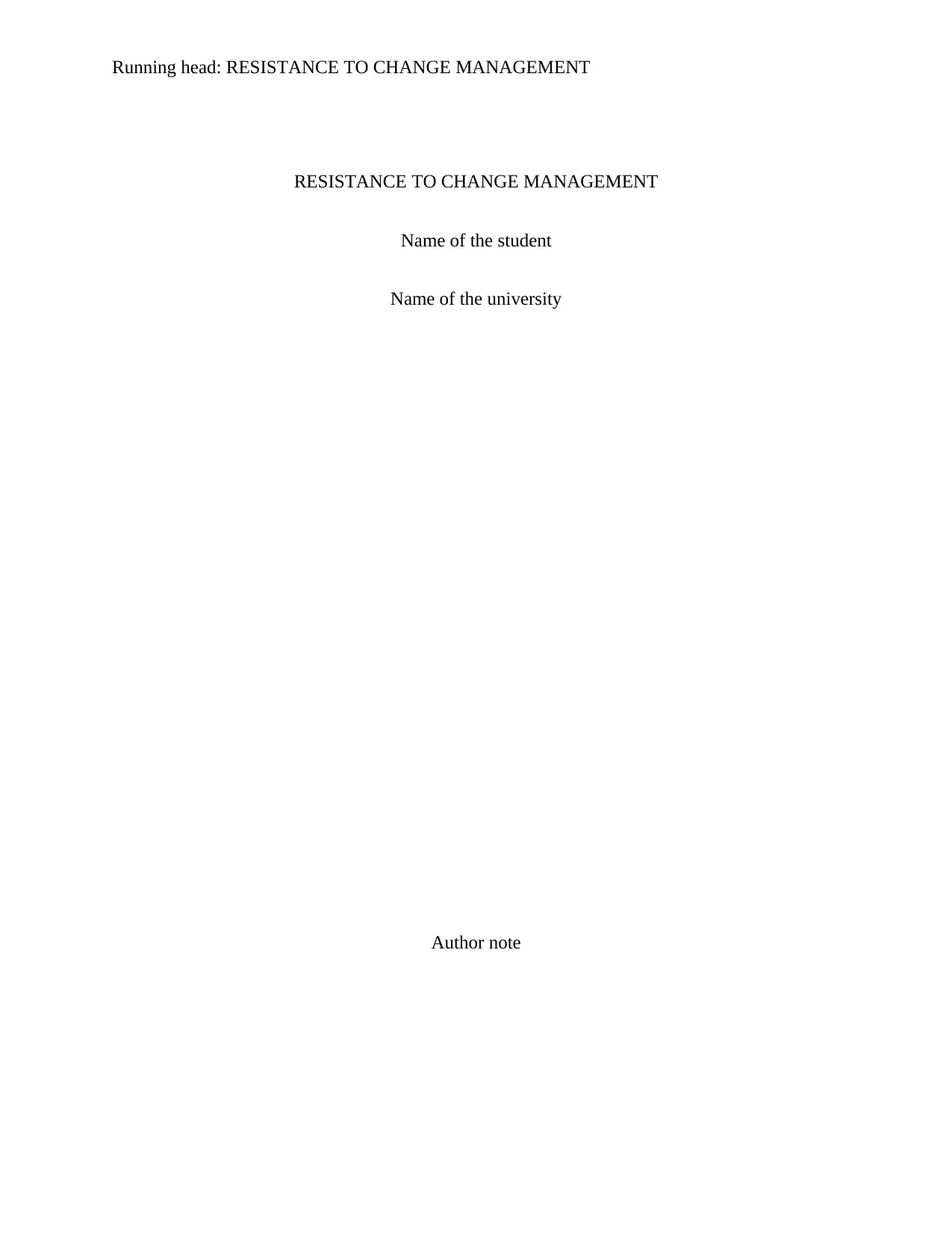
Running head: RESISTANCE TO CHANGE MANAGEMENT
RESISTANCE TO CHANGE MANAGEMENT
Name of the student
Name of the university
Author note
RESISTANCE TO CHANGE MANAGEMENT
Name of the student
Name of the university
Author note
Paraphrase This Document
Need a fresh take? Get an instant paraphrase of this document with our AI Paraphraser

1RESISTANCE TO CHANGE MANAGEMENT
Executive summary
The report aims at examining the reasons for the resistance that is being faced by the
organizations while implementing the change in functioning. The major characteristics of the
resistance are based on determinig the approaches that are being undertaken by the leaders for
bringing in the change. The analysis includes the critical evaluation of the ontologism for
determining the change and their approaches. The report also advocates on the manner in which
the ethical practices gets subdued by the change that is planned by the organization.
Executive summary
The report aims at examining the reasons for the resistance that is being faced by the
organizations while implementing the change in functioning. The major characteristics of the
resistance are based on determinig the approaches that are being undertaken by the leaders for
bringing in the change. The analysis includes the critical evaluation of the ontologism for
determining the change and their approaches. The report also advocates on the manner in which
the ethical practices gets subdued by the change that is planned by the organization.
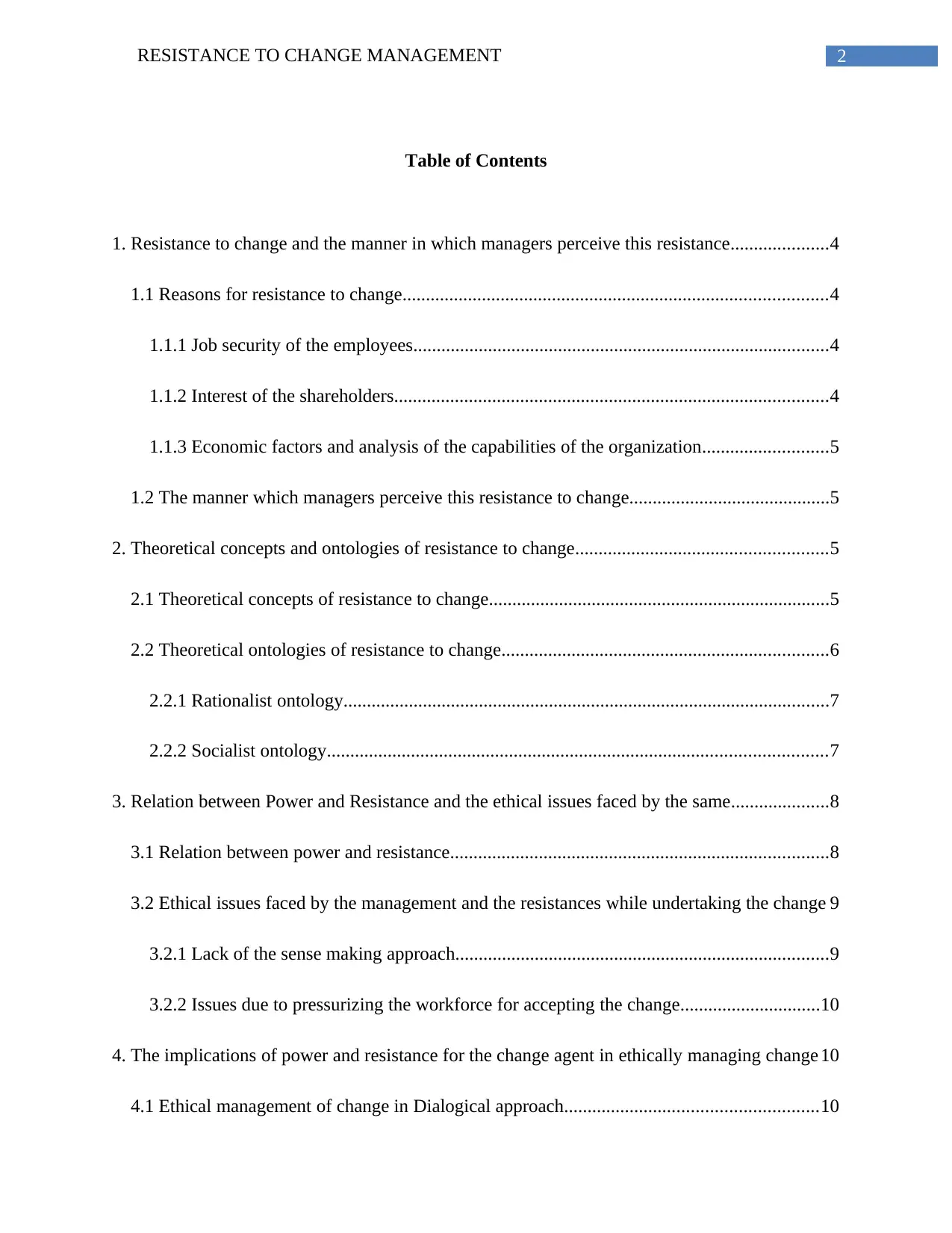
2RESISTANCE TO CHANGE MANAGEMENT
Table of Contents
1. Resistance to change and the manner in which managers perceive this resistance.....................4
1.1 Reasons for resistance to change...........................................................................................4
1.1.1 Job security of the employees.........................................................................................4
1.1.2 Interest of the shareholders.............................................................................................4
1.1.3 Economic factors and analysis of the capabilities of the organization...........................5
1.2 The manner which managers perceive this resistance to change...........................................5
2. Theoretical concepts and ontologies of resistance to change......................................................5
2.1 Theoretical concepts of resistance to change.........................................................................5
2.2 Theoretical ontologies of resistance to change......................................................................6
2.2.1 Rationalist ontology........................................................................................................7
2.2.2 Socialist ontology...........................................................................................................7
3. Relation between Power and Resistance and the ethical issues faced by the same.....................8
3.1 Relation between power and resistance.................................................................................8
3.2 Ethical issues faced by the management and the resistances while undertaking the change 9
3.2.1 Lack of the sense making approach................................................................................9
3.2.2 Issues due to pressurizing the workforce for accepting the change..............................10
4. The implications of power and resistance for the change agent in ethically managing change 10
4.1 Ethical management of change in Dialogical approach......................................................10
Table of Contents
1. Resistance to change and the manner in which managers perceive this resistance.....................4
1.1 Reasons for resistance to change...........................................................................................4
1.1.1 Job security of the employees.........................................................................................4
1.1.2 Interest of the shareholders.............................................................................................4
1.1.3 Economic factors and analysis of the capabilities of the organization...........................5
1.2 The manner which managers perceive this resistance to change...........................................5
2. Theoretical concepts and ontologies of resistance to change......................................................5
2.1 Theoretical concepts of resistance to change.........................................................................5
2.2 Theoretical ontologies of resistance to change......................................................................6
2.2.1 Rationalist ontology........................................................................................................7
2.2.2 Socialist ontology...........................................................................................................7
3. Relation between Power and Resistance and the ethical issues faced by the same.....................8
3.1 Relation between power and resistance.................................................................................8
3.2 Ethical issues faced by the management and the resistances while undertaking the change 9
3.2.1 Lack of the sense making approach................................................................................9
3.2.2 Issues due to pressurizing the workforce for accepting the change..............................10
4. The implications of power and resistance for the change agent in ethically managing change 10
4.1 Ethical management of change in Dialogical approach......................................................10
⊘ This is a preview!⊘
Do you want full access?
Subscribe today to unlock all pages.

Trusted by 1+ million students worldwide
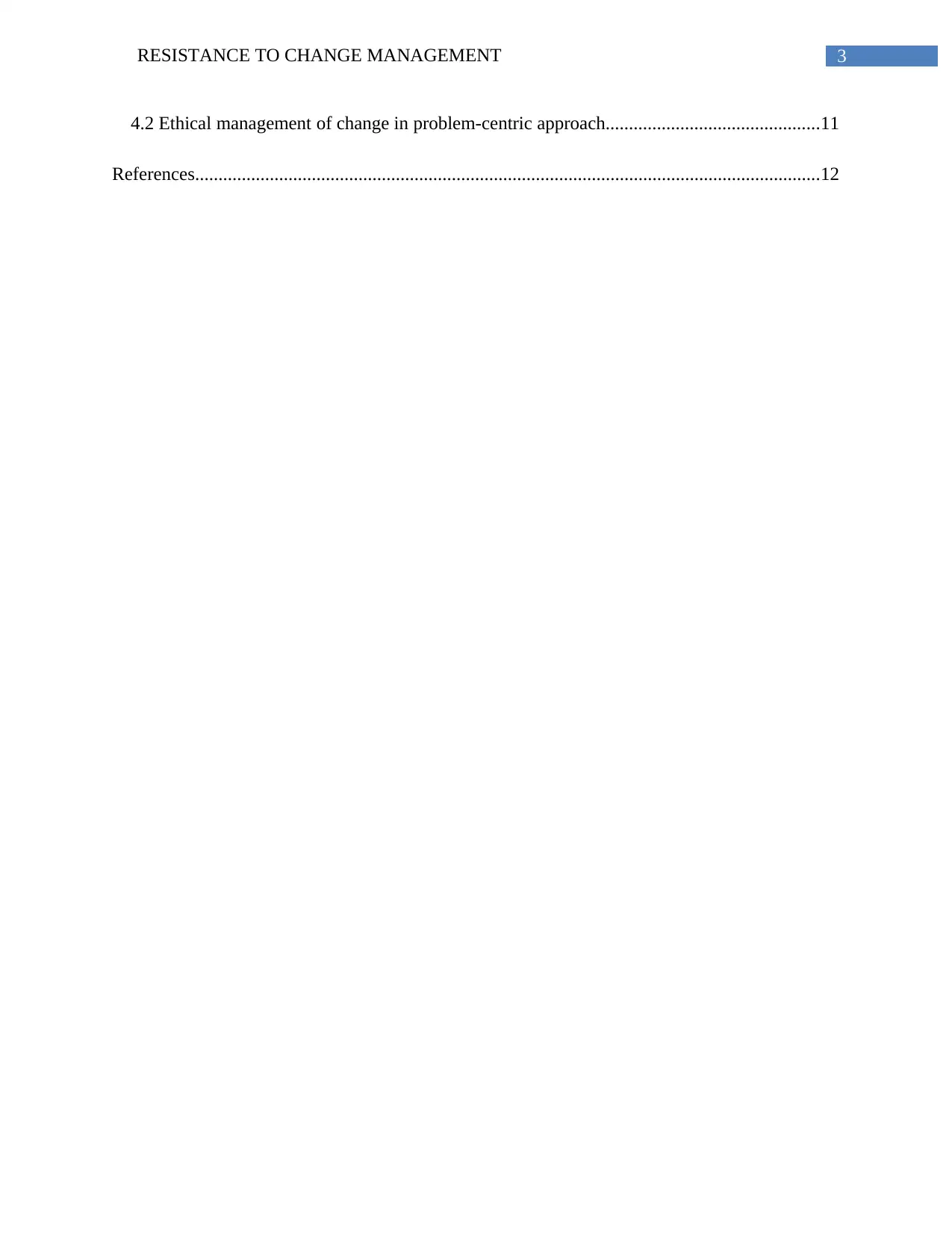
3RESISTANCE TO CHANGE MANAGEMENT
4.2 Ethical management of change in problem-centric approach..............................................11
References......................................................................................................................................12
4.2 Ethical management of change in problem-centric approach..............................................11
References......................................................................................................................................12
Paraphrase This Document
Need a fresh take? Get an instant paraphrase of this document with our AI Paraphraser
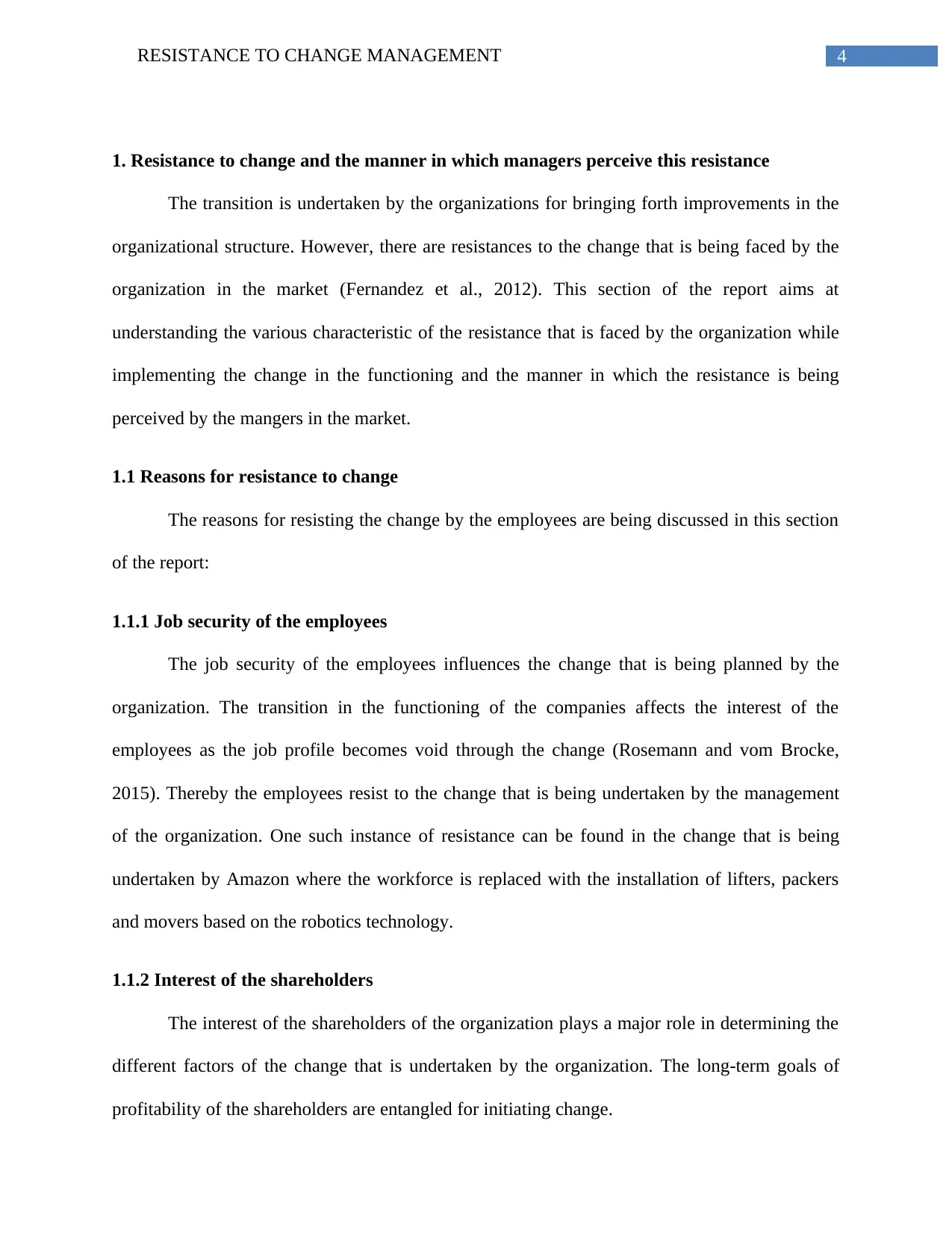
4RESISTANCE TO CHANGE MANAGEMENT
1. Resistance to change and the manner in which managers perceive this resistance
The transition is undertaken by the organizations for bringing forth improvements in the
organizational structure. However, there are resistances to the change that is being faced by the
organization in the market (Fernandez et al., 2012). This section of the report aims at
understanding the various characteristic of the resistance that is faced by the organization while
implementing the change in the functioning and the manner in which the resistance is being
perceived by the mangers in the market.
1.1 Reasons for resistance to change
The reasons for resisting the change by the employees are being discussed in this section
of the report:
1.1.1 Job security of the employees
The job security of the employees influences the change that is being planned by the
organization. The transition in the functioning of the companies affects the interest of the
employees as the job profile becomes void through the change (Rosemann and vom Brocke,
2015). Thereby the employees resist to the change that is being undertaken by the management
of the organization. One such instance of resistance can be found in the change that is being
undertaken by Amazon where the workforce is replaced with the installation of lifters, packers
and movers based on the robotics technology.
1.1.2 Interest of the shareholders
The interest of the shareholders of the organization plays a major role in determining the
different factors of the change that is undertaken by the organization. The long-term goals of
profitability of the shareholders are entangled for initiating change.
1. Resistance to change and the manner in which managers perceive this resistance
The transition is undertaken by the organizations for bringing forth improvements in the
organizational structure. However, there are resistances to the change that is being faced by the
organization in the market (Fernandez et al., 2012). This section of the report aims at
understanding the various characteristic of the resistance that is faced by the organization while
implementing the change in the functioning and the manner in which the resistance is being
perceived by the mangers in the market.
1.1 Reasons for resistance to change
The reasons for resisting the change by the employees are being discussed in this section
of the report:
1.1.1 Job security of the employees
The job security of the employees influences the change that is being planned by the
organization. The transition in the functioning of the companies affects the interest of the
employees as the job profile becomes void through the change (Rosemann and vom Brocke,
2015). Thereby the employees resist to the change that is being undertaken by the management
of the organization. One such instance of resistance can be found in the change that is being
undertaken by Amazon where the workforce is replaced with the installation of lifters, packers
and movers based on the robotics technology.
1.1.2 Interest of the shareholders
The interest of the shareholders of the organization plays a major role in determining the
different factors of the change that is undertaken by the organization. The long-term goals of
profitability of the shareholders are entangled for initiating change.

5RESISTANCE TO CHANGE MANAGEMENT
1.1.3 Economic factors and analysis of the capabilities of the organization
The economic and the financial position of the organization also pose a serious threat to
the transition that is planned by the organization. The resource and the capability of the
organization for undertaking the various aspects of the change also acts as an resistance to the
transition that is being planned by the organization.
1.2 The manner which managers perceive this resistance to change
The resistance to the change that is being faced by the organizations is taken as the
positive attempts of the workforce in bringing in modifications to the change in the structure and
the functioning. According to Larry Page, the manager of Alphabet inc., the resistance is the
positive outcome of the transition that is planned by the company. It helps the organization in
understanding the pros and cons of the change that is being initiated by the management of the
organization (Fairhurst & Connaughton, 2014).
2. Theoretical concepts and ontologies of resistance to change
2.1 Theoretical concepts of resistance to change
The transition that is undertaken by the organizations is determined through the urgency
that is felt by the management of the organization. However, there are possible threats that are
faced by the organizations while undertaking the change in the structure and the functioning of
the same. There are possible situations where the change that is implemented by the organization
affects the wellbeing and the psychology of the employees. Therefore, there are resistances to the
change that are being planned by the organizations.
According to Rosemann and vom Brocke (2015), the change that is being implemented
by the organization affects the employees and their wellbeing. The resistance to the change that
1.1.3 Economic factors and analysis of the capabilities of the organization
The economic and the financial position of the organization also pose a serious threat to
the transition that is planned by the organization. The resource and the capability of the
organization for undertaking the various aspects of the change also acts as an resistance to the
transition that is being planned by the organization.
1.2 The manner which managers perceive this resistance to change
The resistance to the change that is being faced by the organizations is taken as the
positive attempts of the workforce in bringing in modifications to the change in the structure and
the functioning. According to Larry Page, the manager of Alphabet inc., the resistance is the
positive outcome of the transition that is planned by the company. It helps the organization in
understanding the pros and cons of the change that is being initiated by the management of the
organization (Fairhurst & Connaughton, 2014).
2. Theoretical concepts and ontologies of resistance to change
2.1 Theoretical concepts of resistance to change
The transition that is undertaken by the organizations is determined through the urgency
that is felt by the management of the organization. However, there are possible threats that are
faced by the organizations while undertaking the change in the structure and the functioning of
the same. There are possible situations where the change that is implemented by the organization
affects the wellbeing and the psychology of the employees. Therefore, there are resistances to the
change that are being planned by the organizations.
According to Rosemann and vom Brocke (2015), the change that is being implemented
by the organization affects the employees and their wellbeing. The resistance to the change that
⊘ This is a preview!⊘
Do you want full access?
Subscribe today to unlock all pages.

Trusted by 1+ million students worldwide
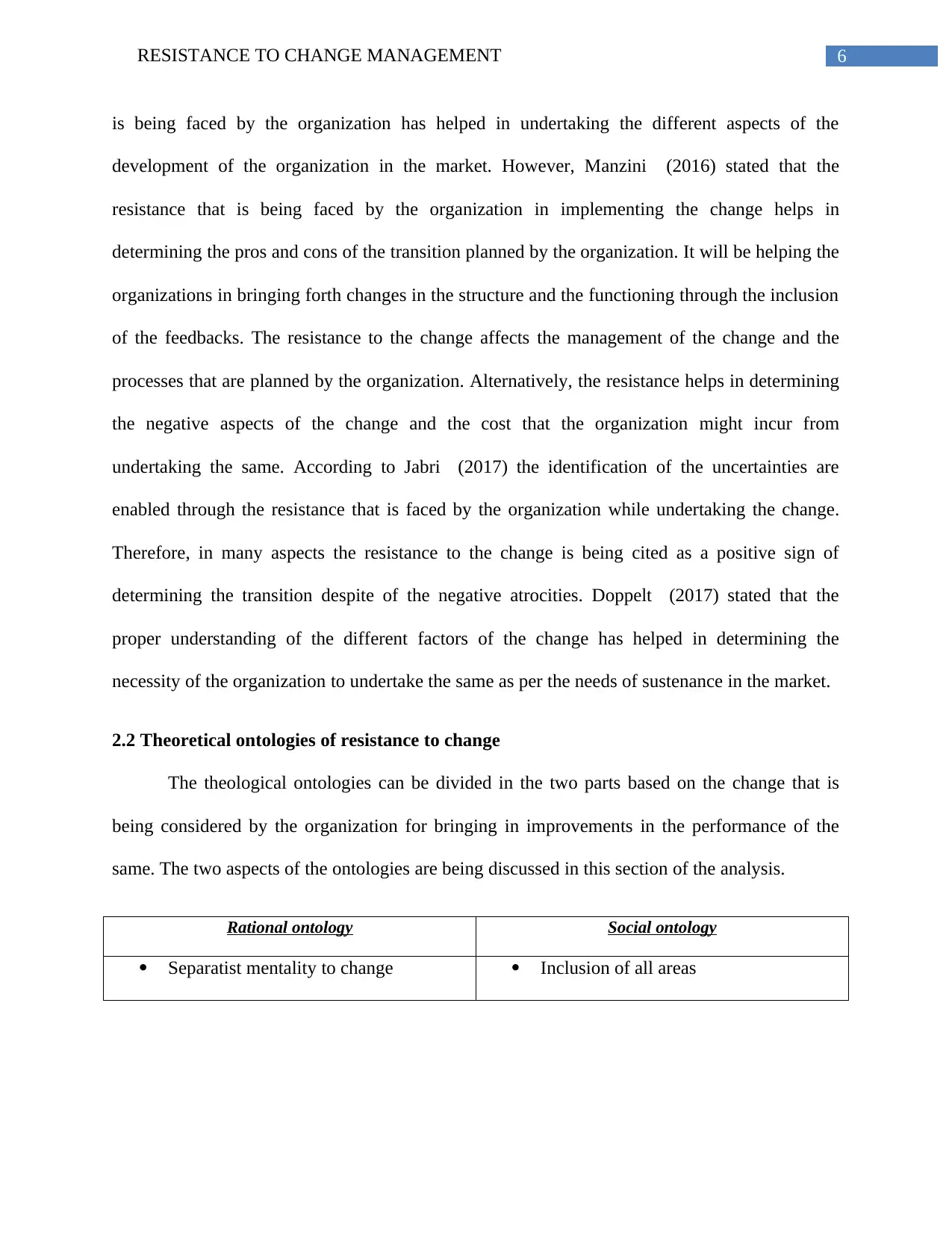
6RESISTANCE TO CHANGE MANAGEMENT
is being faced by the organization has helped in undertaking the different aspects of the
development of the organization in the market. However, Manzini (2016) stated that the
resistance that is being faced by the organization in implementing the change helps in
determining the pros and cons of the transition planned by the organization. It will be helping the
organizations in bringing forth changes in the structure and the functioning through the inclusion
of the feedbacks. The resistance to the change affects the management of the change and the
processes that are planned by the organization. Alternatively, the resistance helps in determining
the negative aspects of the change and the cost that the organization might incur from
undertaking the same. According to Jabri (2017) the identification of the uncertainties are
enabled through the resistance that is faced by the organization while undertaking the change.
Therefore, in many aspects the resistance to the change is being cited as a positive sign of
determining the transition despite of the negative atrocities. Doppelt (2017) stated that the
proper understanding of the different factors of the change has helped in determining the
necessity of the organization to undertake the same as per the needs of sustenance in the market.
2.2 Theoretical ontologies of resistance to change
The theological ontologies can be divided in the two parts based on the change that is
being considered by the organization for bringing in improvements in the performance of the
same. The two aspects of the ontologies are being discussed in this section of the analysis.
Rational ontology Social ontology
Separatist mentality to change Inclusion of all areas
is being faced by the organization has helped in undertaking the different aspects of the
development of the organization in the market. However, Manzini (2016) stated that the
resistance that is being faced by the organization in implementing the change helps in
determining the pros and cons of the transition planned by the organization. It will be helping the
organizations in bringing forth changes in the structure and the functioning through the inclusion
of the feedbacks. The resistance to the change affects the management of the change and the
processes that are planned by the organization. Alternatively, the resistance helps in determining
the negative aspects of the change and the cost that the organization might incur from
undertaking the same. According to Jabri (2017) the identification of the uncertainties are
enabled through the resistance that is faced by the organization while undertaking the change.
Therefore, in many aspects the resistance to the change is being cited as a positive sign of
determining the transition despite of the negative atrocities. Doppelt (2017) stated that the
proper understanding of the different factors of the change has helped in determining the
necessity of the organization to undertake the same as per the needs of sustenance in the market.
2.2 Theoretical ontologies of resistance to change
The theological ontologies can be divided in the two parts based on the change that is
being considered by the organization for bringing in improvements in the performance of the
same. The two aspects of the ontologies are being discussed in this section of the analysis.
Rational ontology Social ontology
Separatist mentality to change Inclusion of all areas
Paraphrase This Document
Need a fresh take? Get an instant paraphrase of this document with our AI Paraphraser
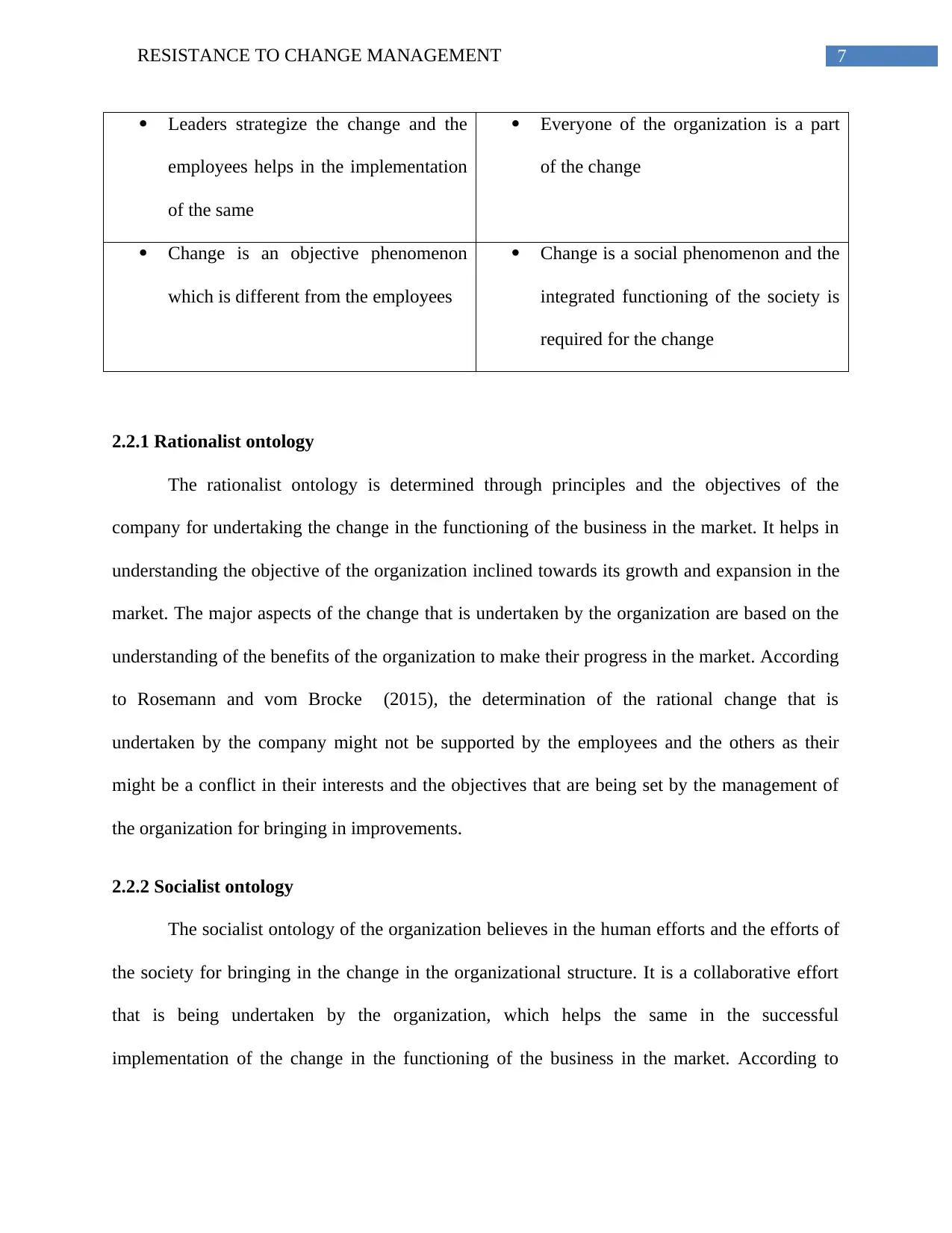
7RESISTANCE TO CHANGE MANAGEMENT
Leaders strategize the change and the
employees helps in the implementation
of the same
Everyone of the organization is a part
of the change
Change is an objective phenomenon
which is different from the employees
Change is a social phenomenon and the
integrated functioning of the society is
required for the change
2.2.1 Rationalist ontology
The rationalist ontology is determined through principles and the objectives of the
company for undertaking the change in the functioning of the business in the market. It helps in
understanding the objective of the organization inclined towards its growth and expansion in the
market. The major aspects of the change that is undertaken by the organization are based on the
understanding of the benefits of the organization to make their progress in the market. According
to Rosemann and vom Brocke (2015), the determination of the rational change that is
undertaken by the company might not be supported by the employees and the others as their
might be a conflict in their interests and the objectives that are being set by the management of
the organization for bringing in improvements.
2.2.2 Socialist ontology
The socialist ontology of the organization believes in the human efforts and the efforts of
the society for bringing in the change in the organizational structure. It is a collaborative effort
that is being undertaken by the organization, which helps the same in the successful
implementation of the change in the functioning of the business in the market. According to
Leaders strategize the change and the
employees helps in the implementation
of the same
Everyone of the organization is a part
of the change
Change is an objective phenomenon
which is different from the employees
Change is a social phenomenon and the
integrated functioning of the society is
required for the change
2.2.1 Rationalist ontology
The rationalist ontology is determined through principles and the objectives of the
company for undertaking the change in the functioning of the business in the market. It helps in
understanding the objective of the organization inclined towards its growth and expansion in the
market. The major aspects of the change that is undertaken by the organization are based on the
understanding of the benefits of the organization to make their progress in the market. According
to Rosemann and vom Brocke (2015), the determination of the rational change that is
undertaken by the company might not be supported by the employees and the others as their
might be a conflict in their interests and the objectives that are being set by the management of
the organization for bringing in improvements.
2.2.2 Socialist ontology
The socialist ontology of the organization believes in the human efforts and the efforts of
the society for bringing in the change in the organizational structure. It is a collaborative effort
that is being undertaken by the organization, which helps the same in the successful
implementation of the change in the functioning of the business in the market. According to

8RESISTANCE TO CHANGE MANAGEMENT
Anderson (2016), the collaborative action of the subordinates and the management helps in the
successful processing of the company after the implementation of the change in the functions.
3. Relation between Power and Resistance and the ethical issues faced by the same
3.1 Relation between power and resistance
There is a critical relation between the distribution of power and the resistance that is
being faced by the organization while implementing the transition. The leadership styles play a
major role in determining the change that is being implemented through the utilization of the
rational ontology for the change in the market (Hesselbarth & Schaltegger, 2014). The major
factor of the change that is undertaken by the organization is based on the understanding of
improvement in the situation. However, at different points of time the resistance to the change
and the objectives of the organization for the change collide resulting to the malfunctioning of
the change in the organization. According to Menzel (2012), the power of hierarchy plays a
major role in driving the change in the organizational structure. It affects the workforce by
forcing the same to bring in the change in the organization. The different approach of power
while determining and implementing the change has resulted to the resistance to the change.
Dawson and Andriopoulos (2014), stated that the change is of two types- one being ‘employee
centric’ and the other ‘organization centric’. An employee centric change helps in enhancing the
position and the functioning of the workforce through the determination of the needs of the same
for the smooth functioning (Chambers, Glasgow & Stange, 2013). On the other hand, the
organization centric change is based on the understanding of the objectives and the principles
that are being set by the management for bringing in improvements in the situation of the
Anderson (2016), the collaborative action of the subordinates and the management helps in the
successful processing of the company after the implementation of the change in the functions.
3. Relation between Power and Resistance and the ethical issues faced by the same
3.1 Relation between power and resistance
There is a critical relation between the distribution of power and the resistance that is
being faced by the organization while implementing the transition. The leadership styles play a
major role in determining the change that is being implemented through the utilization of the
rational ontology for the change in the market (Hesselbarth & Schaltegger, 2014). The major
factor of the change that is undertaken by the organization is based on the understanding of
improvement in the situation. However, at different points of time the resistance to the change
and the objectives of the organization for the change collide resulting to the malfunctioning of
the change in the organization. According to Menzel (2012), the power of hierarchy plays a
major role in driving the change in the organizational structure. It affects the workforce by
forcing the same to bring in the change in the organization. The different approach of power
while determining and implementing the change has resulted to the resistance to the change.
Dawson and Andriopoulos (2014), stated that the change is of two types- one being ‘employee
centric’ and the other ‘organization centric’. An employee centric change helps in enhancing the
position and the functioning of the workforce through the determination of the needs of the same
for the smooth functioning (Chambers, Glasgow & Stange, 2013). On the other hand, the
organization centric change is based on the understanding of the objectives and the principles
that are being set by the management for bringing in improvements in the situation of the
⊘ This is a preview!⊘
Do you want full access?
Subscribe today to unlock all pages.

Trusted by 1+ million students worldwide
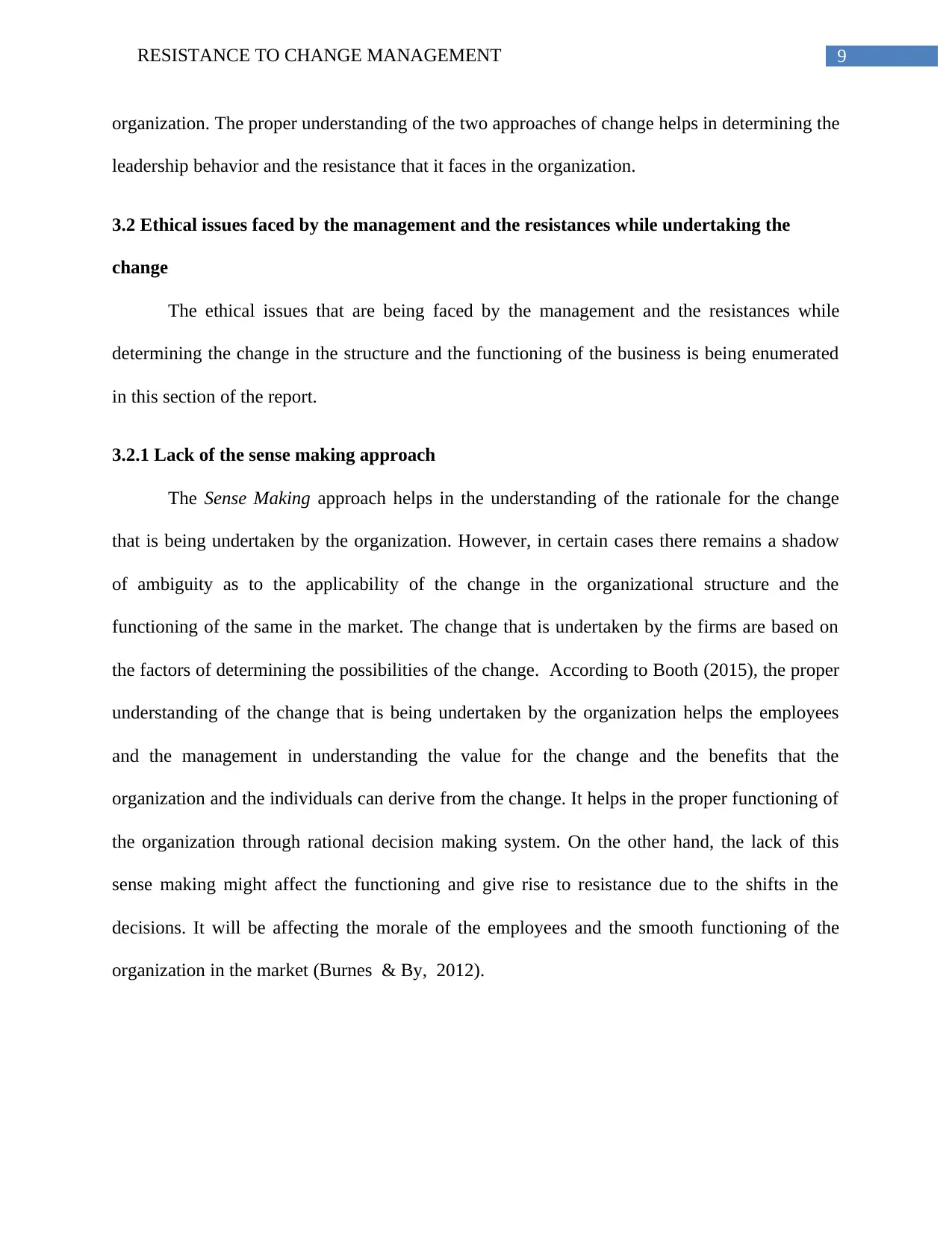
9RESISTANCE TO CHANGE MANAGEMENT
organization. The proper understanding of the two approaches of change helps in determining the
leadership behavior and the resistance that it faces in the organization.
3.2 Ethical issues faced by the management and the resistances while undertaking the
change
The ethical issues that are being faced by the management and the resistances while
determining the change in the structure and the functioning of the business is being enumerated
in this section of the report.
3.2.1 Lack of the sense making approach
The Sense Making approach helps in the understanding of the rationale for the change
that is being undertaken by the organization. However, in certain cases there remains a shadow
of ambiguity as to the applicability of the change in the organizational structure and the
functioning of the same in the market. The change that is undertaken by the firms are based on
the factors of determining the possibilities of the change. According to Booth (2015), the proper
understanding of the change that is being undertaken by the organization helps the employees
and the management in understanding the value for the change and the benefits that the
organization and the individuals can derive from the change. It helps in the proper functioning of
the organization through rational decision making system. On the other hand, the lack of this
sense making might affect the functioning and give rise to resistance due to the shifts in the
decisions. It will be affecting the morale of the employees and the smooth functioning of the
organization in the market (Burnes & By, 2012).
organization. The proper understanding of the two approaches of change helps in determining the
leadership behavior and the resistance that it faces in the organization.
3.2 Ethical issues faced by the management and the resistances while undertaking the
change
The ethical issues that are being faced by the management and the resistances while
determining the change in the structure and the functioning of the business is being enumerated
in this section of the report.
3.2.1 Lack of the sense making approach
The Sense Making approach helps in the understanding of the rationale for the change
that is being undertaken by the organization. However, in certain cases there remains a shadow
of ambiguity as to the applicability of the change in the organizational structure and the
functioning of the same in the market. The change that is undertaken by the firms are based on
the factors of determining the possibilities of the change. According to Booth (2015), the proper
understanding of the change that is being undertaken by the organization helps the employees
and the management in understanding the value for the change and the benefits that the
organization and the individuals can derive from the change. It helps in the proper functioning of
the organization through rational decision making system. On the other hand, the lack of this
sense making might affect the functioning and give rise to resistance due to the shifts in the
decisions. It will be affecting the morale of the employees and the smooth functioning of the
organization in the market (Burnes & By, 2012).
Paraphrase This Document
Need a fresh take? Get an instant paraphrase of this document with our AI Paraphraser

10RESISTANCE TO CHANGE MANAGEMENT
3.2.2 Issues due to pressurizing the workforce for accepting the change
There are ethical issues that are being faced by the organization when the management of
the same undertakes ways to pressurize the workforce for accepting the transition that is planned
by the company (Booth, 2015). The change might clash with the interests and the emotions of the
people working under the management, which affects the smooth functioning of the same. The
understanding of the welfare of the people helps in understanding the different aspects of the
transition. According to Fugate, Prussia and Kinicki (2012), the clash between the management
of the employees creates a resistive force that affects the smooth functioning and thereby affects
the improvements that are being planned by the organization through the implementation of the
change.
4. The implications of power and resistance for the change agent in ethically managing
change
The implications that are being faced by the change agent while managing the change
ethically is being determined through the understanding of the different approaches are being
discussed in this section of the analysis.
4.1 Ethical management of change in Dialogical approach
The ethical management of the change agent is based on the application of the same on
the dialogic approach. The dialogic approach perceives the change that is being planned by the
organization holistically. It helps in determining the challenges that are being faced by the
employees while performing their respective job roles in the organization (Pieterse, Caniëls &
Homan, 2012). The change agent might feel the pressure from the management for bringing in
the change in the organization, which might be not favorable for the employees. On the other
3.2.2 Issues due to pressurizing the workforce for accepting the change
There are ethical issues that are being faced by the organization when the management of
the same undertakes ways to pressurize the workforce for accepting the transition that is planned
by the company (Booth, 2015). The change might clash with the interests and the emotions of the
people working under the management, which affects the smooth functioning of the same. The
understanding of the welfare of the people helps in understanding the different aspects of the
transition. According to Fugate, Prussia and Kinicki (2012), the clash between the management
of the employees creates a resistive force that affects the smooth functioning and thereby affects
the improvements that are being planned by the organization through the implementation of the
change.
4. The implications of power and resistance for the change agent in ethically managing
change
The implications that are being faced by the change agent while managing the change
ethically is being determined through the understanding of the different approaches are being
discussed in this section of the analysis.
4.1 Ethical management of change in Dialogical approach
The ethical management of the change agent is based on the application of the same on
the dialogic approach. The dialogic approach perceives the change that is being planned by the
organization holistically. It helps in determining the challenges that are being faced by the
employees while performing their respective job roles in the organization (Pieterse, Caniëls &
Homan, 2012). The change agent might feel the pressure from the management for bringing in
the change in the organization, which might be not favorable for the employees. On the other
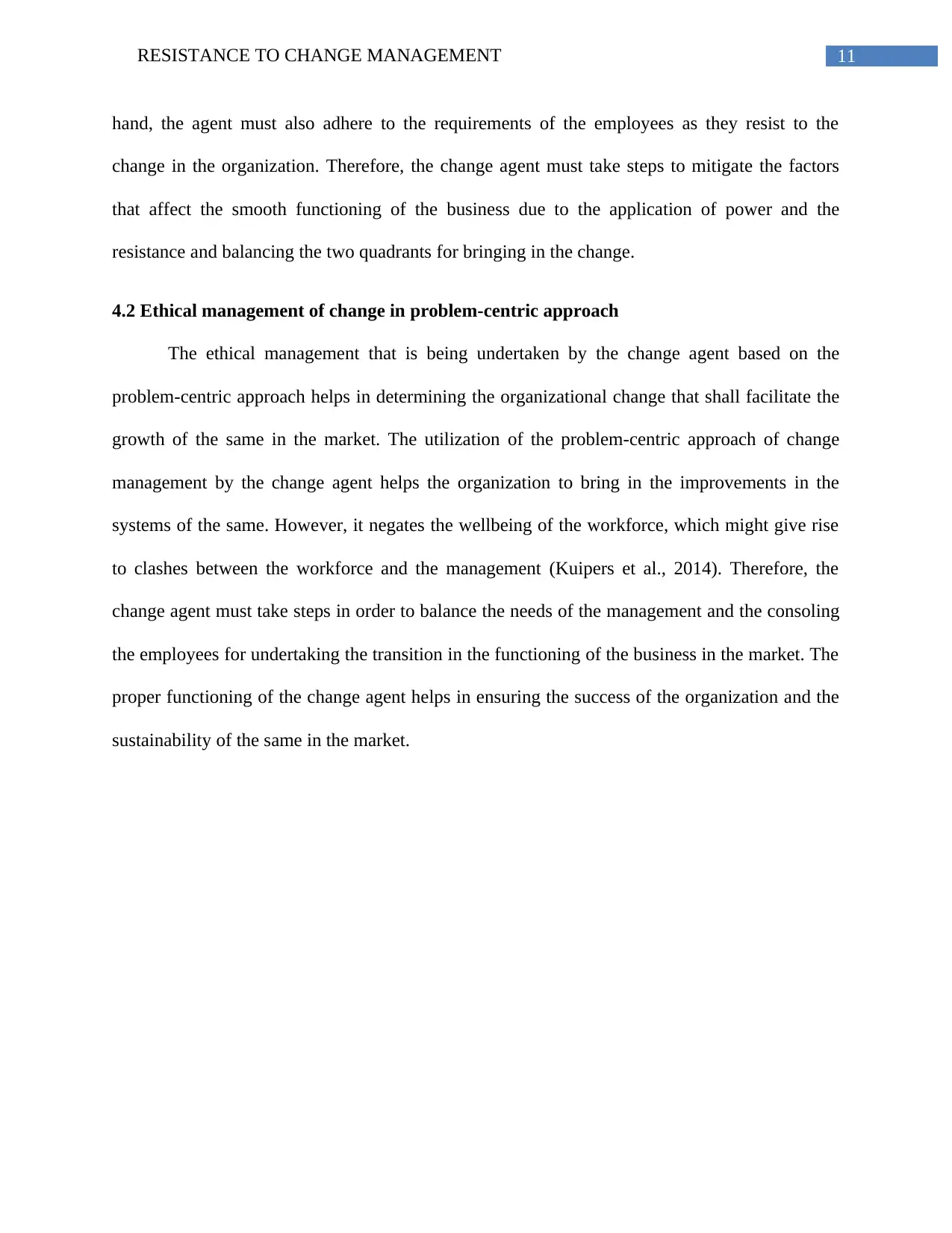
11RESISTANCE TO CHANGE MANAGEMENT
hand, the agent must also adhere to the requirements of the employees as they resist to the
change in the organization. Therefore, the change agent must take steps to mitigate the factors
that affect the smooth functioning of the business due to the application of power and the
resistance and balancing the two quadrants for bringing in the change.
4.2 Ethical management of change in problem-centric approach
The ethical management that is being undertaken by the change agent based on the
problem-centric approach helps in determining the organizational change that shall facilitate the
growth of the same in the market. The utilization of the problem-centric approach of change
management by the change agent helps the organization to bring in the improvements in the
systems of the same. However, it negates the wellbeing of the workforce, which might give rise
to clashes between the workforce and the management (Kuipers et al., 2014). Therefore, the
change agent must take steps in order to balance the needs of the management and the consoling
the employees for undertaking the transition in the functioning of the business in the market. The
proper functioning of the change agent helps in ensuring the success of the organization and the
sustainability of the same in the market.
hand, the agent must also adhere to the requirements of the employees as they resist to the
change in the organization. Therefore, the change agent must take steps to mitigate the factors
that affect the smooth functioning of the business due to the application of power and the
resistance and balancing the two quadrants for bringing in the change.
4.2 Ethical management of change in problem-centric approach
The ethical management that is being undertaken by the change agent based on the
problem-centric approach helps in determining the organizational change that shall facilitate the
growth of the same in the market. The utilization of the problem-centric approach of change
management by the change agent helps the organization to bring in the improvements in the
systems of the same. However, it negates the wellbeing of the workforce, which might give rise
to clashes between the workforce and the management (Kuipers et al., 2014). Therefore, the
change agent must take steps in order to balance the needs of the management and the consoling
the employees for undertaking the transition in the functioning of the business in the market. The
proper functioning of the change agent helps in ensuring the success of the organization and the
sustainability of the same in the market.
⊘ This is a preview!⊘
Do you want full access?
Subscribe today to unlock all pages.

Trusted by 1+ million students worldwide
1 out of 15
Related Documents
Your All-in-One AI-Powered Toolkit for Academic Success.
+13062052269
info@desklib.com
Available 24*7 on WhatsApp / Email
![[object Object]](/_next/static/media/star-bottom.7253800d.svg)
Unlock your academic potential
Copyright © 2020–2025 A2Z Services. All Rights Reserved. Developed and managed by ZUCOL.





